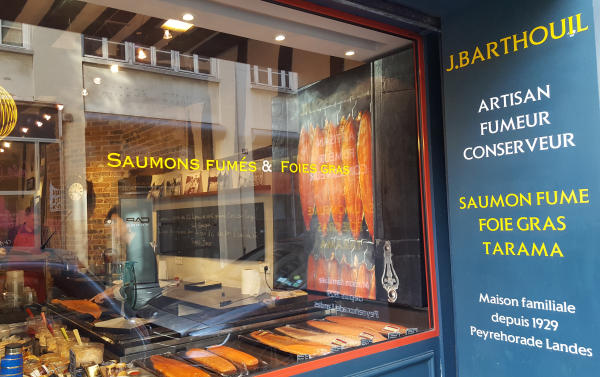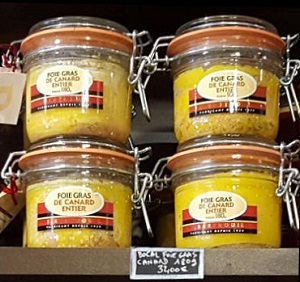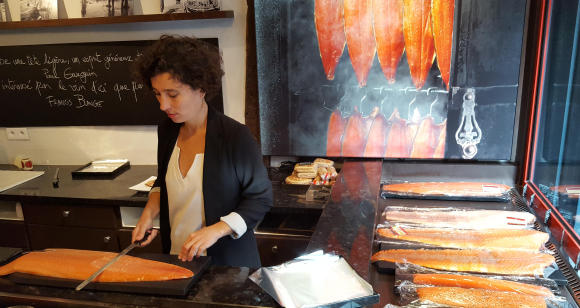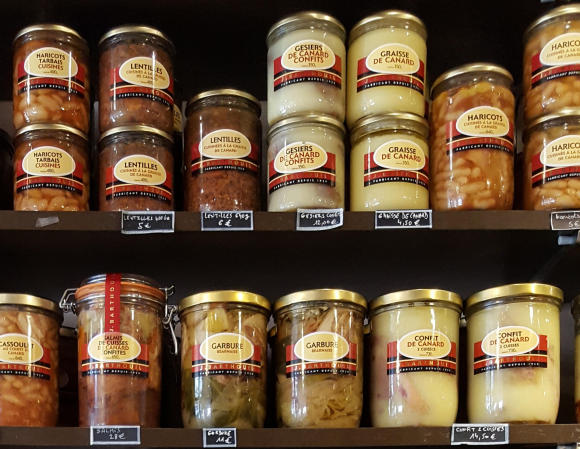
What do foie gras and smoked salmon have in common?
For one, they’re both staples of the French celebratory and holiday table and of plenty of hospitable tables and cocktail events in between.
For two, they’re both produced with excellence and tradition by Maison Barthouil, a family business located in the small town of Peyrehorade in the Landes department of southwest France, between Béarn and Basque Country.
While Barthouil products (under the J. Barthouil brand) are sold in a handful of luxury grocers throughout France, in some restaurants and online, their only shop outside of their home village is in Paris, in the Upper Marais. That’s where I met with Pauline Barthouil, the company’s sales director and granddaughter of its founder.
Foie Gras
Fattened duck liver (foie gras de canard) and all manner of duck preparations have long graced the table in southwest France. They can thank European explorations in the Americas for returning home with the prime ingredients for foie gras: large ducks and the corn with which to (force-)feed them.
 The Barthouil family, however, gets to call their affection for all things duck a truly local affair since their business is based on a traditional model of agriculture. Hatcheries in the area deliver 1-day-old ducklings to five breeders whose farms are located within 25 miles of Peyrehorade. The breeders then raise a safe of about 400 ducks for 16 weeks until slaughter. The breeders also grow their own corn, which represents 50% of the ducks’ diet while being raised and 100% during the 12-13-day fattening period known as gavage. Gavage is the force-feeding that gives such a delicious taste and buttery texture to the fattened liver. It is also the technique that occasionally gets the production of foie gras banned in certain parts of the U.S.. (Pauline Barthouil emphasizes the gentleness of the breeders’ handling during gavage and the calm of the feeding room.)
The Barthouil family, however, gets to call their affection for all things duck a truly local affair since their business is based on a traditional model of agriculture. Hatcheries in the area deliver 1-day-old ducklings to five breeders whose farms are located within 25 miles of Peyrehorade. The breeders then raise a safe of about 400 ducks for 16 weeks until slaughter. The breeders also grow their own corn, which represents 50% of the ducks’ diet while being raised and 100% during the 12-13-day fattening period known as gavage. Gavage is the force-feeding that gives such a delicious taste and buttery texture to the fattened liver. It is also the technique that occasionally gets the production of foie gras banned in certain parts of the U.S.. (Pauline Barthouil emphasizes the gentleness of the breeders’ handling during gavage and the calm of the feeding room.)
Some 25,000 ducks are raised and slaughtered each year for their products. J. Barthouil transforms the entire duck, since in addition to producing various types of duck foie gras (different preparations of entier or whole foie gras and of mi-cuit or semi-cooked foie gras), along with mousse and terrine, the company also makes the duck versions of rillettes (pulled duck cooked in duck fat and served cold as an hors d’oeuvre spread), confit (a drool-worthy main course of duck cooked in its own fat), cassoulet (a hearty duck and white bean dish), fresh breast or duck steak (magret), smoked, dried magret, and other preparations. Barthouil also produces some goose foie gras.
I asked Pauline Barthouil two nagging questions:
The first: Is there a difference between whole foie gras in a tin and in a jar? The answer: No.
The second: Several or more years ago I gave to my sister a jar of foie gras that she’s yet to open. The sell-by date has rubbed off and, not knowing how old it is, she’s wonders if it’s safe to eat. Do we dare eat the foie gras inside the next time I visit? Her answer: Absolutely! For me, she said, it gets better with time. So as long as it’s still properly sealed you can consider the suggested sell-by date as simply a legal obligation.
Smoked salmon
Salmon was abundant in western France until about a century ago, when numbers, already dwindling, began falling more dramatically. As they migrate inland from salty seas, some salmon, however, are still found in the rivers and streams of Brittany, in the Loire, and in the Adour and its confluents, i.e. Barthouil territory.
Pauline Barthouil’s grandfather Gaston would have known days of abundance, which is probably why, when he became aware of the novelty of Scandinavian smoking, he might have though, “Hey, I’ve got salmon, I’ve got land, let’s build a smokehouse and start smoking.” Except that he had no experience in smoking salmon. His amateur attempts were likely so smoked that they tasted more like fishy ash than lightly smoked fish.
He therefore sent his production manager to Denmark to learn from European pros of preserving through smoking. Thus the Danish tradition became the tradition of the Bartouil family, which continues to follow much the same method as in the late 1950s, though with indirect smoking rather than the original method of direct smoking. (Pauline’s sister Guillemette Barthouil is the current production manager).

Local Adour wild salmon, which the company considers “the Rolls Royce of its kind,” still appears on the Barthouil menu, where it weighs in at 315€ per kilo in its sliced smoke version. The vast majority of the production, however, is shipped from far north: wild salmon from the Baltic Sea, Norway and Scotland, along with farm-raised salmon from Scotland (organic) and Norway. Smoked and sliced, these salmons range in cost from 107-182€ per kilo.
Plump salmon arrives whole (gutted) and fresh three days after slaughter. The salmon is hand salted with dry salt from Salies de Béarn, 12 miles east. After drying, it is cold smoked (68-75°F) for 20 hours with alder wood, a type of birch, which gives only a slight woody taste. Alder had been used by their Danish “teachers” yet needn’t be imported since it grows abundantly in France, including in the southwest.
Among the eight types of J. Barthouil smoked salmon available, there’s an exquisite wild Scottish salmon (175€/kilo), but I particularly enjoy the subtlety and refinement taste of the wild salmon from Norway’s Namesen Fjord (150€/kilo), whose taste hints at the krill that it feeds on. I also appreciate for its distinctiveness the wild salmon from the Baltic Sea salmon (130€/kilo), which feeds in part on herring, giving it its gray-beige in color and a slight herring taste.
Tarama
A third specialty of the house is tarama, a fish-roe spread that’s frequently served with the aperitif in Paris. Barthouil’s seven tarama recipes all use Islandic cod eggs and rapeseed oil, to which may be added fresh crab or Espelette pepper (two personal favorites), scallops, sea urchin (for those ready to be launched into an iodized coastal fantasy), truffles or algae.
French caviar is also available in the shop. The shop also sells some accompanying wine and spirits, often with an eye to southwestern producers, such as Lactalium vodka distilled in Gers from cow’s milk from Auvergne.
© 2017, Gary Lee Kraut
Maison Barthouil’s Paris boutique, J. Barthouil: 41 rue Charlot, 3rd arr. Tel. 01 42 78 32 88. Metro Temple or Filles du Calvaire. Closed Monday. Nicolas Ferrand, glimpsed in the first video, provides friendly counsel in the Paris shop, which he manages.
The video below, from the Barthouil website, tells of the company history and gives a step-by-step presentation of its production of foie gras and smoked salmon. It is narrated by Jacques Barthouil, son of Gaston, father Pauline and Guillemette. Company president and primary shareholder, he is the J. of J. Barthouil.


